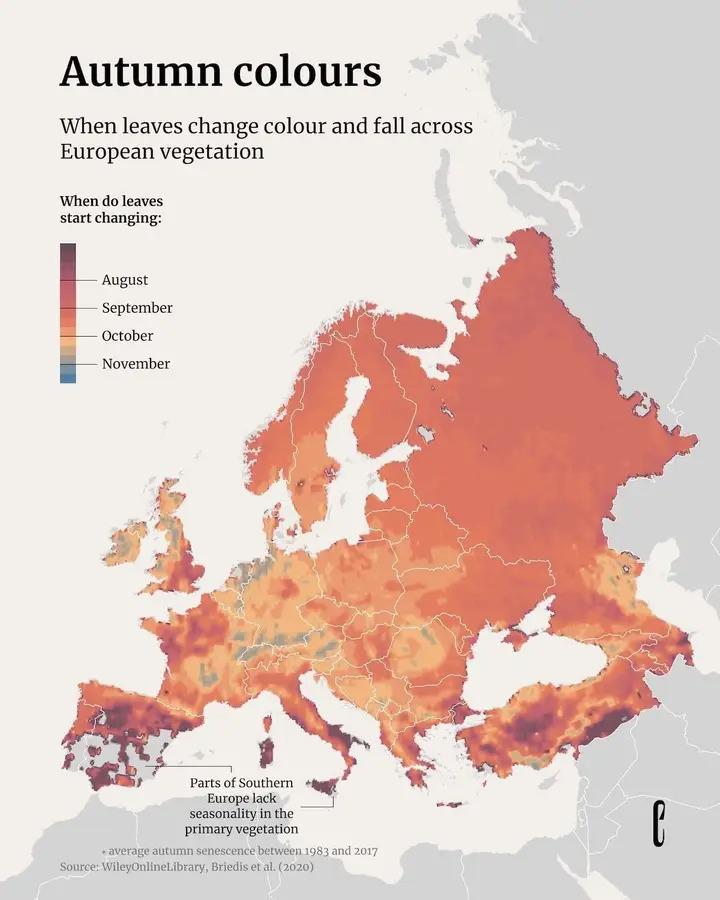Autumn Leaf Color Change Map of Europe


Marcus Rodriguez
Historical Geography Expert
Marcus Rodriguez specializes in historical cartography and geographic data analysis. With a background in both history and geography, he brings unique...
Geographic Analysis
What This Map Shows
The map titled "The Autumn Spectacle Across Europe" visually represents the onset of autumn leaf color changes across the continent. Utilizing a gradient from dark red to orange-beige, it illustrates a simple yet powerful geographic truth: the further north you go, the earlier autumn begins. In Scandinavia, vibrant hues start to emerge as early as August, while much of Central and Western Europe transitions in September. Southern regions, including parts of France, Italy, and the Balkans, experience this transformation peaking around October. Understanding this natural phenomenon—known as leaf senescence—offers insight into how temperature, daylight, and geography shape our environment.
Deep Dive into Leaf Senescence
Leaf senescence is a fascinating natural process that marks the transition of trees from lush greens to vibrant autumn colors. This phenomenon is primarily triggered by changes in climate and daylight length, which varies significantly across Europe due to its diverse latitudinal range.
As summer fades and autumn approaches, shorter days and cooler temperatures signal trees to prepare for winter. The breakdown of chlorophyll, the pigment responsible for the green color in leaves, reveals other pigments such as carotenoids and anthocyanins. Carotenoids produce the brilliant yellows and oranges we see, while anthocyanins can create stunning reds. Interestingly, the intensity of these colors can vary based on weather conditions leading up to the autumn months, such as temperature fluctuations and sunlight exposure.
In higher latitudes, particularly Scandinavia, this process begins earlier. For instance, in Norway and Sweden, trees such as birches and aspens can start to show their colors as early as mid-August. The rapid shift in daylight hours and cooler nighttime temperatures accelerates chlorophyll breakdown, allowing other pigments to shine through.
Conversely, in southern Europe, the warmer climate and longer growing season delay this process. Regions like southern France, Italy, and the Balkans typically see their leaves changing colors later, peaking around late October. This delay is also influenced by the Mediterranean climate, characterized by hot, dry summers and mild, wet winters.
Moreover, the type of vegetation plays a crucial role. While deciduous trees, which shed their leaves annually, display dramatic color changes, many Mediterranean forests consist of evergreen species like holm oaks and pines. These trees do not undergo a significant seasonal leaf change, which is why southern Europe lacks the vibrant fall foliage seen in northern regions. Ever wondered why you don’t see those vivid fall colors in the south? It’s all about the types of trees and their adaptations to the climate!
Regional Analysis
Let’s break down how autumn unfolds across different regions in Europe, as depicted in the map.
**Scandinavia**: As mentioned, this region experiences the earliest onset of autumn colors. In countries like Sweden, Finland, and Norway, the cold climate and shorter days trigger leaf senescence by August. The birch trees, common in these areas, turn a striking yellow, while maples can display brilliant reds.
**Central and Western Europe**: Moving southward, we find countries such as Germany, Poland, and the Czech Republic, where September marks the peak of autumn colors. Here, the transition is a beautiful mix of yellow, orange, and red hues as trees like oaks and maples start to change. This region often enjoys more stable weather patterns, which can enhance the vibrancy of fall colors.
**Southern Europe**: In contrast, the southern regions experience a much later peak in autumn colors. Countries like Italy and Greece showcase a subtler transformation, with peak colors appearing in late October. The predominant evergreen species in Mediterranean forests means that while some trees may change colors, the overall spectacle is less dramatic. However, deciduous trees like chestnuts and sweetgums can still offer glimpses of color among the greenery.
Significance and Impact
Understanding the timing of leaf senescence and the stunning transformation of trees during autumn is more than just a visual delight. It has significant implications for agriculture, tourism, and even climate change. For instance, farmers need to be aware of these seasonal changes to optimize crop cycles and harvest times. Furthermore, the autumn leaf display attracts tourists, contributing to the economies of many regions.
Moreover, as climate patterns shift due to global warming, we may see changes in these seasonal cycles. Some regions might experience earlier or later onset of autumn colors, affecting local ecosystems and wildlife dependent on these seasonal cues. It’s essential to monitor these changes, as they can provide insight into broader environmental trends.
In conclusion, the autumn leaf color change map of Europe not only illustrates a beautiful aspect of nature but also opens a window into the intricate relationships between climate, geography, and ecology. As the continent prepares for winter, it offers us a stunning array of colors, reminding us of the cyclical nature of life and the beauty that emerges from change.
Visualization Details
- Published
- October 13, 2025
- Views
- 138
Comments
Loading comments...